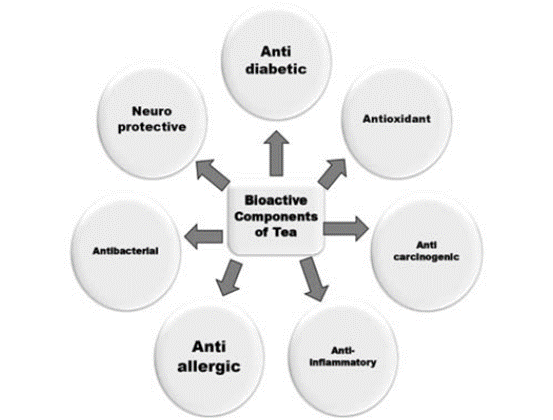Tea is the second most consumed beverage in the world, after water. Although “herbal tea” can be made from a variety of ingredients, true tea comes from the leaves of the Camellia sinensis plant. Tea is mainly prepared in fermented (black tea), unfermented (green tea), and semifermented (oolong tea) forms. These forms contain many health-promoting compounds with neuroprotective, antioxidant, anti-inflammatory, and anti-hypertensive properties (Hayat 2015).
Both fermented and unfermented teas are associated with health benefits and may help reduce the risk of cardiovascular disease, diabetes, and even cancer (Khan 2013). Polyphenol compounds such as EGCG are responsible for many of tea's antioxidant and anti-inflammatory benefits. Tea’s polyphenol compounds also support metabolic detoxification, endothelial function, and immunity and can decrease platelet aggregation (Serafini 2011).
Tea contains additional bioactive compounds that support health, such as quercetin, minerals, lignans, and amino acids. The amino acid L-theanine is found in green and black tea, with the highest concentrations being found in black Darjeeling tea at 250 mg/100 grams of tea (Sena 2020). L-theanine accounts for many of the neuroprotective, antioxidant, and anti-inflammatory benefits of tea (Li 2022).
Ultimately, tea is a beneficial plant-based beverage with a wide range of health benefits. Enjoying a nice cup of tea can have relaxation and restorative benefits as well!
 Source: Sena, Gargi, et al. "Bioactive components of tea." Archives of Food and Nutritional Science 4.1 (2020): 001-009. This is an open access article distributed under the Creative Commons Attribution License, which permits unrestricted use, distribution, and reproduction in any medium, provided the original work is properly cited.
Source: Sena, Gargi, et al. "Bioactive components of tea." Archives of Food and Nutritional Science 4.1 (2020): 001-009. This is an open access article distributed under the Creative Commons Attribution License, which permits unrestricted use, distribution, and reproduction in any medium, provided the original work is properly cited.
Hayat, Khizar et al. “Tea and its consumption: benefits and risks.” Critical reviews in food science and nutrition vol. 55,7 (2015): 939-54. doi:10.1080/10408398.2012.678949
Khan, Naghma, and Hasan Mukhtar. “Tea and health: studies in humans.” Current pharmaceutical design vol. 19,34 (2013): 6141-7. doi:10.2174/1381612811319340008
Li, Ming-Yue et al. “L-Theanine: A Unique Functional Amino Acid in Tea (Camellia sinensis L.) With Multiple Health Benefits and Food Applications.” Frontiers in nutrition vol. 9 853846. 4 Apr. 2022, doi:10.3389/fnut.2022.853846
Sena, Gargi, et al. "Bioactive components of tea." Archives of Food and Nutritional Science 4.1 (2020): 001-009.
Serafini, Mauro, et al. “Health Benefits of Tea.” Herbal Medicine: Biomolecular and Clinical Aspects, edited by Iris F. F. Benzie et. al., 2nd ed., CRC Press/Taylor & Francis, 2011.